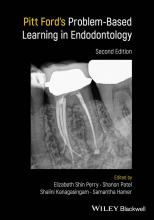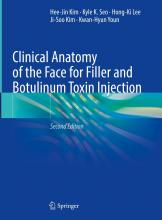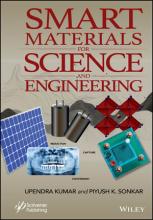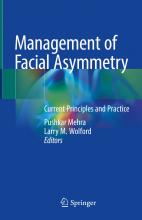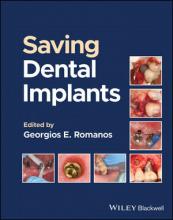New Books - September 2024
New eBooks
Local Flaps in Facial Reconstruction: A Defect Based Approach / by Velupillai Ilankovan, Madan Ethunandan, Tian Ee Seah
Springer 2024
"Written by three consultants with extensive skin cancer experience and international reputations for excellence, this book provides comprehensive practical solutions for defects in the head and neck region that clinicians are confronted with in day-to-day practice. The first edition of the “local flaps in facial reconstruction- a defect base approach” was published nearly four years ago and has since been well received around the world and translated into other languages. This second edition is intended to facilitate the decision-making process and provide practical,step-by-step guidance on reconstructing specific defects in the facial region.
The frequency of skin cancer continues to rise around the globe, and clinicians with various backgrounds are involved in the care of these patients. In this book, new procedures are described and “old” ones re-evaluated. The current edition has been extensively updated with new text and diagrams so as to provide comprehensive practical solutions for frequently encountered facial defects. Color diagrams and clinical photographs have been included where necessary to provide additional details. The original ethos of creating a text that can be used in everyday practice, while also including personal comments, is maintained.Given the scope, the book is ideal for use by clinicians and trainees in daily practice, and will help to achieve excellent cosmetic outcomes in this aesthetically sensitive part of the body." From the publisher's website.
Aligner Systems in Invisible Orthodontics: Basic Concepts and Clinical Management / by Stefan Abela
Springer 2024
"This richly illustrated book describes the processes, techniques and biomechanics involved in providing aligner treatment for different types of malocclusions. It opens with an overview of the material characteristics and the basic concepts of aligner therapy including topics like biocompatibility and intraoral deterioration. The main part of the book is dedicated to the various types of aligners, the methods used in their application and the practical aspects of delivery. It is structured based on the type of malocclusion being managed giving the reader a systematic pattern and a practical way of progressing through the book. The book closes with a discussion of the scientific data available.
This comprehensive step-by-step guide on aligner systems is a must have for both dental undergraduate and postgraduate dental students as well as for fully practising clinicians who want to deepen their knowledge in this innovative technique." From the publisher's website.
Pitt Ford's Problem-Based Learning in Endodontology / edited by Elizabeth Shin Perry Shanon Patel, Shalini Kanagasingam, Samantha Hamer
Wiley 2025
"Pitt Ford's Problem-Based Learning in Endodontology, 2nd Edition, is an essential reference for Endodontology, enriched with the latest research and clinical evidence. Employing a problem-based approach, it consolidates readers' knowledge and diagnostic skills. Prepared by an international team of clinical academics, this edition reflects the latest advances in the field.
Encouraging self-directed learning, the authors present diverse clinical cases covering topics such as non-odontogenic pain, pulp preservation, endodontic treatment, restoration, regenerative endodontic procedures, and trauma. Each section is accompanied by images as well as further reading recommendations.
A touchstone to key areas concerning the dental pulp and the root canal system, Pitt Ford's Problem-Based Learning in Endodontology is a valuable resource for dental students, residents, and clinicians seeking the latest techniques and procedures in Endodontology." From the publisher's website.
Clinical Anatomy of the Face for Filler and Botulinum Toxin Injection / by Hee-Jin Kim, Kyle K. Seo, Hong-Ki Lee, Ji-Soo Kim, Kwan-Hyun Youn
Springer 2024
"In the second edition of this highly successful book, the authors once again aim to equip the reader with up-to-date information. This book, containing more than 200 cadaveric photos and 200 illustrations, aims to familiarize physicians practicing botulinum neurotoxin type A (BoNT-A) and filler injection with the anatomy of the facial mimetic muscles, vessels, and soft tissues in order to enable them to achieve optimum cosmetic results while avoiding possible adverse events. Anatomic considerations of importance when administering BoNT-A and fillers are identified and in addition invaluable clinical guidelines are provided, highlighting, for example, the preferred injection points for BoNT-A and the adequate depth of filler injection. Unique insights are also offered into the differences between Asians and Caucasians with regard to relevant anatomy. The contributing authors include an anatomist who offers distinctive anatomic perspectives on BoNT-A and filler treatments and three expert physicians from different specialties, namely a dermatologist, a plastic surgeon, and a cosmetic physician, who share insights gained during extensive clinical experience in the use of BoNT-A and fillers." From the publisher's website.
Illustrated Manual of Orthognathic Surgery: Osteotomies of the Mandible / edited by Peter Kessler, Nicolas Hardt, Kensuke Yamauchi
Springer 2024
"This first volume in a multi-volume series considers the gains in information and knowledge that have resulted from preoperative and postoperative 3D imaging using new radiologic protocols in maxillofacial surgery, with the corresponding consequences for the surgeon. It contrasts the established standard techniques of orthognathic oral and maxillofacial surgery with new considerations and insights based on years of experience and analysis of clinical activity in this subspecialty of oral and maxillofacial surgery.
The book is deliberately structured so that the clinical situation is juxtaposed with a graphic representation for better understanding, which is intended to point out special situations that can in turn positively influence the surgical planning and execution of the procedure in order to avoid undesirable results in individual cases. Graphic representations illustrate the three-dimensionality of the complex splitting technique of the mandible where text or radiographs are insufficient.
A corresponding book that combines clinical anatomical situations with pre- and postoperative preparation and clear explanation does not yet exist. It is aimed at a wide readership of students and professionals in oral and maxillofacial surgery, orthodontics, plastic and craniofacial surgery, and otolaryngology." From the publisher's website.
Smart Materials for Science and Engineering / edited by Upendra Kumar, Piyush Kumar Sonkar
Scrivener 2024
"Smart materials, also known as advanced or creative materials, are described as advanced materials that react intuitively to environmental changes or as materials that can return to their original shape in response to certain stimuli. Smart materials are classified as either active or passive based on their characteristics. There are two types of active materials. The first kind cannot change its characteristics when subjected to outside stimuli, for example photochromatic spectacles that only alter their color when exposed to sunlight. The other, which includes piezoelectric materials, can change one sort of energy (thermal, electrical, chemical, mechanical, or optical) into another. When subjected to external pressure, it can generate an electric charge. As an example, optical fibers can transmit electromagnetic waves. In contrast, passive smart materials can transmit a specific sort of energy. They have some amazing qualities that set them apart from other materials, such as transiency, meaning they can react to different kinds of external stimuli immediately, self-actuation or the capacity to change their appearance and shape, selectivity where the response is divided and expected, directness when the response is limited to the activating event, shape-changing where the material can change its shape to external stimuli, their ability to determine their own health, also known as self-diagnosis, and their ability to self-heal.
The ability to synthesize novel materials has substantially progressed thanks to science and technology over the past 20 years. They fall mostly into the following four categories: polymers, ceramics, metals, and smart materials. Among these, smart materials are gaining popularity since they have more uses than conventional materials. Smart materials are unusual substances that have the ability to alter their properties, such as those that can immediately change their phase when placed near a magnet or their shape simply by applying heat. Humanity will be significantly impacted by this new era of smart materials. For instance, some of them can adapt their properties to the environment, some have sensory capabilities, some can repair themselves automatically, and some can degrade themselves. These extraordinary properties of smart materials will have an effect on all facets of civilization. There are many different types of intelligent materials, including magnetorheological materials, electro-rheostat materials, shape memory alloys, piezoelectric materials, and more.
This book describes many forms of smart materials and their possible uses in various fields. A literature survey discusses the different types of smart materials, such as based ceramics, polymers, and organic compounds and their needs, advantages, disadvantages, and applications will be comprehensively discussed. A discussion of well-established smart materials including piezoelectric, magnetostrictive, shape memory alloy, electro-rheological fluid, and magnetorheological fluid materials will be discussed with their present prospects." From the publisher's website.
Management of Facial Asymmetry: Current Principles and Practice / edited by Pushkar Mehra, Larry M. Wolford
Springer 2024
"This book provides clear practical guidance on the contemporary management of patients with asymmetry of facial structures. Patient evaluation and diagnosis are first fully described. Key radiological and orthodontic considerations are identified and the role of virtual surgical planning is explained. Individual chapters then focus on management principles in patients with craniosynostosis, hemifacial microsomia, condylar hyperactivity, and temporomandibular ankylosis/degenerative disease. The remainder of the book is devoted to the state of the art in treatment procedures, covering distraction osteogenesis, the use of facial implants, diverse soft tissue procedures, and jaw and other osteotomies. The text is augmented by informative clinical cases, easy-to-follow tables, photographs, and illustrations. The authors are highly experienced clinicians well recognized for their expertise in this area. The book will be ideal for all clinicians involved in the care of patients afflicted by facial asymmetry and will in particular be an indispensable tool for those who evaluate and treat the condition in day-to-day practice." From the publisher's website.
Saving Dental Implants / edited by Georgios E. Romanos
Wiley 2024
"Saving Dental Implants offers a complete reference to all factors in long-term success in dental implants. Taking an interdisciplinary approach, each chapter is written by leading experts in the field. The book examines treatment outcomes, provides advice on how to manage implants for long-term success, and supports clinicians in avoiding and managing peri-implant complications.
The text presents global treatment approaches and concepts—established philosophies in practice for the last 20 years—and also looks to possible future management strategies. Designed to help clinicians apply the concepts in practice, the text also covers the pros and cons of implant therapy and the specifics of pre-implant diagnostics, treatment methodology, prosthetic concepts, and further maintenance visits.
Featuring hundreds of high-quality color photographs to support the text, Saving Dental Implants covers topics such as:
- The anatomic features of peri-implant tissues, including clinical and histological information, and an evaluation of the studies using different implant systems and prosthetic concepts
- Diagnostic tools and procedures to make the proper diagnosis of peri-implant conditions, and microbiota of the peri-implant tissues and diagnostic opportunities for bacterial diagnosis
- Nanoparticles found in the peri-implant tissues from the implant placement, their loading, and their impact on peri-implant diseases
- The significance, applications, and limitations of bone grafting techniques to optimize the shape of the alveolar ridge
- New technologies for better treatment of peri-implant complications
Examining the most current information and research on diagnosing, preventing, and managing peri-implant complications, Saving Dental Implants is a must-have practical reference for dental practitioners, specialists, and students who wish to help patients reach the best functional and esthetic outcomes." From the publisher's website.
3D Printing at Hospitals and Medical Centers: A Practical Guide for Medical Professionals / edited by Frank J. Rybicki, Jonathan M. Morris, Gerald T. Grant
Springer 2024
"This new edition describes the fundamentals of three-dimensional (3D) printing as applied to medicine and extends the scope of the first edition of 3D Printing in Medicine to include modern 3D printing within Health Care Facilities, also called at the medical “Point-Of-Care” (POC). This edition addresses the practical considerations for, and scope of hospital 3D printing facilities, image segmentation and post-processing for Computer Aided Design (CAD) and 3D printing. The book provides details regarding technologies and materials for medical applications of 3D printing, as well as practical tips of value for physicians, engineers, and technologists.
Individual, comprehensive chapters span all major organ systems that are 3D printed, including cardiovascular, musculoskeletal, craniomaxillofacial, spinal, neurological, thoracic, and abdominal. The fabrication of maxillofacial prosthetics, the planning of head and neck reconstructions, and 3D printed medical devices used in cranial reconstruction are also addressed. The second edition also includes guidelines and regulatory considerations, costs and reimbursement for medical 3D printing, quality assurance, and additional applications of CAD such as virtual reality. There is a new Forward written by Ron Kikinis, PhD and a new Afterword written by Michael W. Vannier, MD.
This book offers radiologists, surgeons, and other physicians a rich source of information on the practicalities and expanding medical applications of 3D printing. It will also serve engineers, physicist, technologists, and hospital administrators who undertake 3D printing. The second edition is designed as a textbook and is expected to serve in this capacity to fill educational needs in both the medical and engineering sectors." From the publisher's website.



